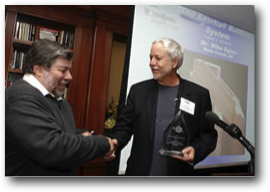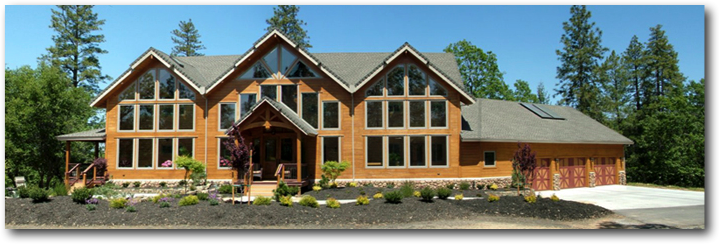ENERTIA HOMES
No Fuel? No Power? .......No Problem
FROM CASUAL OBSERVATION to MODERN MARVEL
When builder Michael Sykes pulled a tarp over a pack of Southern Yellow Pine timbers, on a Christmas eve in the 1970’s, he felt heat radiating from the wood- much like you feel the heat when walking by a recently parked car. Trained as an engineer, he noted: this could be useful. But he did not know, then, that his observation would lead to the most significant innovation in house-building in modern times.
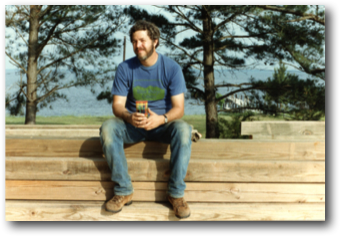
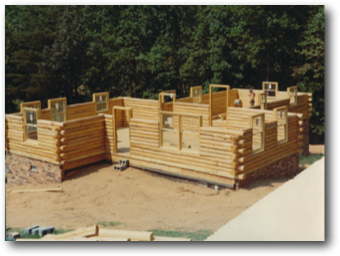
Sykes was putting himself through engineering school by framing houses in Raleigh, North Carolina. He was getting frustrated by the flimsiness, and inefficiency of “stick-frame” homes and had started building log homes. Remembering his timber and heat-storing observations, he started to build log homes of the local Southern Yellow Pine, despite the fact that its book “R” value was less than the cedar he had been using. As he predicted, the Yellow Pine log homes were more energy efficient than the cedar homes and several clients reported they did not even use their furnaces till after Christmas. The wood was storing energy by a process called “thermal inertia.” Contrary to conventional thinking, this thermal inertia was more important than “R” value in the performance of these massive homes.
Why pine? Using a stopwatch, a meat thermometer, and the kitchen oven he tested multiple species of wood. Unlike most woods, the pines flat-lined: the relationship between energy and temperature was not linear. This indicates a change-of-phase, a trait of the resin unique to pine.
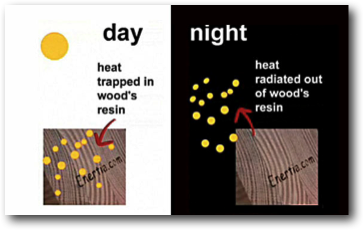

The 1970’s- remember the gas lines- were America’s first “Solar Age.” Natural gas and fuel oil shortages made many newer northern homes un-heatable. Fuel costs were astronomical if you could find it. Many solar home designs were popping up but the challenge in solar home design was storing the sun’s energy for the night, and the next few, possibly cloudy, days. Complicated designs involving rock beds, and water tanks, were the prevalent thinking. Yet ninety-five percent of all American houses are made of wood, and Sykes knew if the wooden structure of the house could store solar energy it would be a breakthrough. It was time to utilize his “warm-pile-of-timber” in a back-to-the-drawing-board total upset of the conventional way of building.

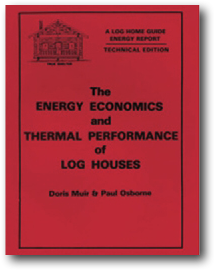
This was a new field, a new technology. Sykes had to develop his own ratios and equations to explain and design with the new phenomena, which he named “Enertia” defined as Energy from a shift-in-time. His guidebook for design and data, was a little known text called the Thermal Performance of Log Houses by Paul Osborne, and Canadian publisher Doris Muir. This book first exposed to the public and science community the embarrassing US Bureau of Standards energy tests in Maryland where a log house out performed the then prevalent DOE stick house standards. Muir immediately grasped the significance of Sykes’ invention and began to promote it in her magazines.
He realized that far more solar energy strikes a house than can be absorbed by just the exterior wood walls in the sun. If he could get more energy, in contact with the right amount and type of wood, a totally self-heating house was mathematically and theoretically possible.
The answer was in the new, and highly publicized, Greenhouse Effect. Concerns were that solar energy entering the earth’s atmosphere could not get out. Sykes reasoned, this same Greenhouse Effect could bring in and distribute solar energy, in the same way, through his heavy timber structure.
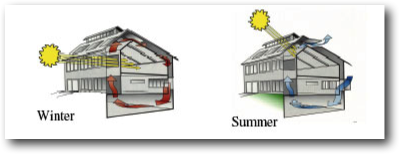
He developed a design with a space, mimicking Earth’s atmosphere, between two log walls, to transfer and accept the maximum amount of solar energy. Thermal energy would move, by convection, just like the trade-winds in Earth’s atmosphere. The pine walls would not only absorb and store the energy- but would later act as radiators to warm the occupants.
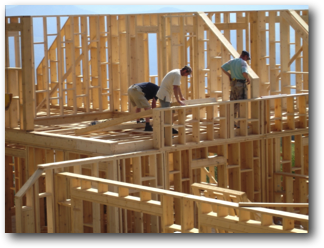
Other than the few formulas in the Osborne/ Muir book- Sykes was on his own. He had to write his own equations and develop and confirm design guidelines. He began to get adept and comfortable working with the Enertia concept while the whole rest of the country’s housing industry went down a different, dangerous and futile, “tightness” path.
The stick frame builders tried to make their homes more energy efficient by wrapping and taping the enclosure with plastic house-wraps, and seam caulking. There was a dangerous side effect to these measures- indoor air became toxic due to outgassing from paint, synthetics, and particularly the particle board that was replacing lumber used for sub-flooring and sheathing.
The stick frame builders tried to make their homes more energy efficient by wrapping and taping the enclosure with plastic house-wraps, and seam caulking. There was a dangerous side effect to these measures- indoor air became toxic due to outgassing from paint, synthetics, and particularly the particle board that was replacing lumber used for sub-flooring and sheathing.
The Enertia technology was a totally different approach- retaining heat in the structure, rather than the air. Comfort comes from radiant energy of the warm walls and floors, not from being immersed in hot air. Anyone who has stood outside in the snow on a sunny day knows the difference- invigorating warmth, not the warmth from sweltering air artificially heated to the point of sleepiness.
Through his log home clients, Sykes had developed considerable expertise and reputation in what were then called Off-Grid and Survival Homes. In many western states the power companies could not cross federal land to serve a house, or the distance was too great and costly, so his clients used wind turbines and solar panels to produce their own electricity. Water came from roof-top collection and cisterns. Common sense, tradition, or religion required large well designed pantries and root cellars. Sykes had a client in Maine, about to build an extreme security compound- in a viciously cold climate. Did he want to try the new double wall, convection-loop concept?
The idea, combining the thick, bullet-proof double log walls, with the ability to self-heat in Maine, was appealing and the client said “go for it”. Thus the first natural self-heating solid wood house in America was underway.
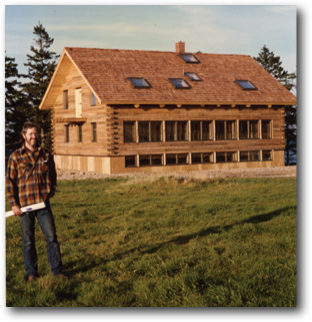
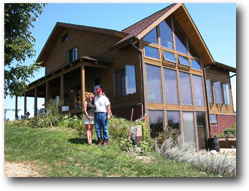
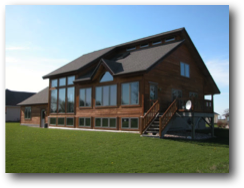
Sykes realized that most clients wanted energy-efficiency but did not need full off-grid capability, and most did not want the rustic look of a log home. Using his mathematical model he developed a line of pre-designed traditional albeit contemporary-looking homes that could easily be adapted to different climates.
Most of these, as well as many custom-designed Enertia® homes using the same principles, have now been built in 25 states, all with different site conditions and climates.
This housing category, using all natural materials and natural physics, that Enertia pioneered 25 years ago is now called “Green” building. The convection loop, based on earth’s atmosphere and the greenhouse effect, is now called “Biomimicry.” Using the properties of a material to store energy at a molecular level, is now called “Nanotechnology.” Taking carbon out of the air and out of circulation for hundreds of years, as with solid wooden walls, is now called “Carbon Sequestration.” Using components that can be disassembled and reused forever is now called “cradle-to-cradle design.”


In 2006 the History Channel, TIME Magazine, and the US Patent Office held a competition called the Invent Now Challenge, to find America’s most significant and potentially life-changing new invention. More than 2,200 inventions were whittled down to 25 finalists and among them was the Enertia Building System. Sykes and a scale model of an Enertia house were at the final judging at Citigroup Center in New York City. Judges included inventors, technology writers, and Apple Computer founder Steve Wozniak. Finalists were interviewed by Science Friday host Ira Flatow.
Sykes, the Raleigh North Carolina homebuilder, was feeling humble as scientific and medical break-throughs were being announced, in reverse order as is done in contests. Then Wozniak announced the Grand Prize winner of the entire Challenge- it was the Enertia Building System. What started as a casual observation of a pile of wood eventually became the most significant innovation in home energy and residential building of modern time. A house that heats and cools itself without fuel or electricity, built economically from a kit of 100% renewable materials that clean the air as they grow, is mind-boggling, but now reality. Enertia® is both a new energy concept, and a new form of architecture. Shelter has been redefined by a new design and technology that is truly a Modern Marvel.
